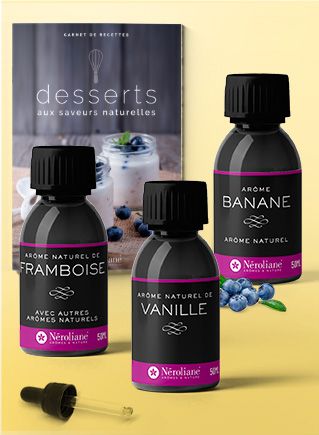Discover the latest natural organic flavours!
I discoverThe use of food flavourings requires some skill. You have to know how to dose them to get the desired result. Depending on the type of flavour chosen and the volume used, one can transform a met or recipe.
You can …
Give a particular aroma a preparation (sweets, syrups, marshmallow) Enhance an existing taste in a preparation (cream, pasta, biscuits) Correct or rebalance insufficient or deficient taste in a preparation or a basic product (fruit purée, fruit pulp, fruit paste, creams) Compensate the aromatic loss of a preparation after cooking.
Aroma, the right dose ... that's all. (Or the art of fine dosing the aroma)
How to properly dose aromas is a recurring question. It has to be said that there are two schools in this field which often find an echo in the way in which everyone cooks. Far from opposing them, there are two visions of creativity that rub shoulders. Whatever the method, provided that the pleasure is at the key in this marvelous space of freedom that is the kitchen.
Thus, we will recognize …
"Methods": they strictly follow the indications of the labels and apply mathematical dosages. For them, the b-a ba of the kitchen is to know how to read! They leave nothing to chance.
"Intuitive": They dose to instinct, pour a few drops, taste, adjust, seek ... in short experiment until gradually obtain the expected result.
You recognized yourself? All you have to do is choose your next recipe and the aromas you need to succeed with flair!
The "Néroliane" advice
The dosage indications are from 1 to 10% of the preparation according to the flavours (between 1 and 10 g per kg). The most common dosage is 0.5% (5g per kg or 5ml per liter of preparation). For refractory mathematics: between a teaspoon (4ml) and a tablespoon (10ml) per liter of preparation.
Have a light hand with some aromas. They do not all have the same power. Thus an aroma of mint will inevitably be less dosed than a strawberry flavour. Cooking tends to reduce the intensity of the flavour. Increase the dosage for a baked cake or pastry.
Keep the aromas
Like any natural product, aromas are sensitive to their environment. In fact, aromatic losses or taste changes occur as a result of misuse.
It is therefore advisable to observe some basic rules to preserve your aromas at best: After each use, close the bottle well and keep it cool and protected from light. Thus, you can use it to its D.L.U.O (Deadline for optimal use) inscribed on its packaging and to realize many recipes with serenity.
A Look at the Label (Have a look on the label)
The labeling of flavourings is strictly regulated. What should you find?
Are mandatory :
- The indication of one or more flavours
- The nature of the aroma (natural flavour, synthetic flavour, natural flavour identical to ...)
- The presence of allergen. Indeed, aromas from sensitive foods (strawberries, flavourings of flowers, gingerbread, aromatics ...) are likely to cause allergies and trigger a crisis. Be vigilant for you and your guests!
- The DLU (Optimum Use Deadline)








